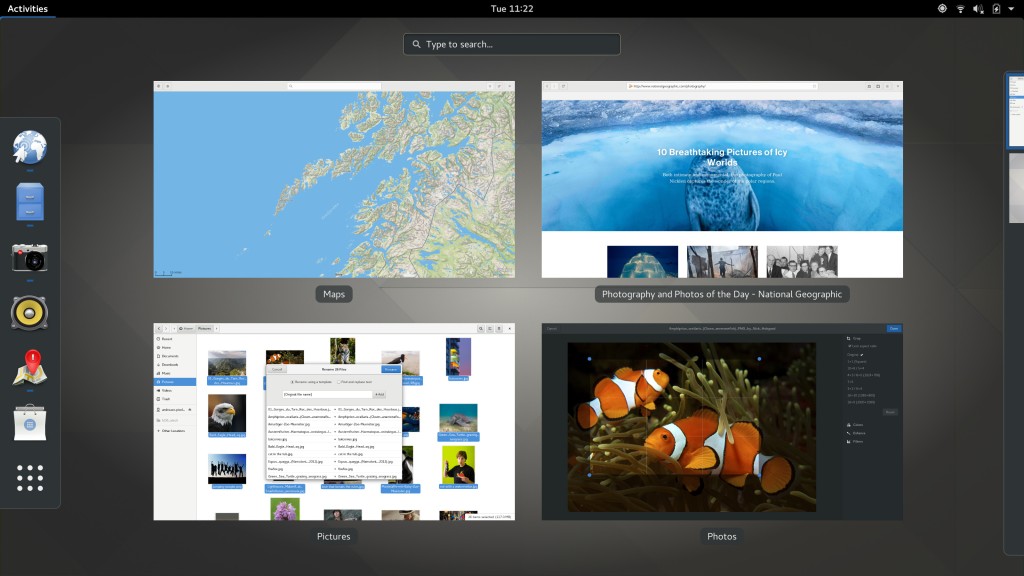CentOS 8 Graphical User Interface (GNOME 3.28)
To work on a Linux system directly, you will need to provide a username and password. Linux systems have two basic modes for a system to run in: either quick and sober in text console mode, which looks like DOS with mouse, multitasking, and multi-user features, or in graphical mode, which looks better but eats more system resources.
Here, the default graphical mode of the CentOS 8 desktop environment is GNOME 3.28. The graphical mode is the default nowadays on most desktop computers. You know you will connect to the system using graphical mode when you are asked for your username and password. To log in, make sure the mouse pointer is in the login window, click on your username and enter your password to the system and click OK or press Enter. It can take a little while before the graphical environment is started, depending on the CPU speed of your computer, the software you use, and your personal settings.
It is generally considered a bad idea to connect (graphically) using the root username, Which is the system administrator’s account, since the use of graphics includes running a lot of extra programs, in root’s case with a lot of extra permissions. So to keep all risks as low as possible, use a normal user account to connect graphically. But there are enough risks to keep this in mind as a general advice, for all use of the root account: only log in as root when extra privileges are required.
Visual overview of GNOME 3 GNOME 3 features a completely reimagined user interface designed to stay out of your way, minimize distractions, and help you get things done. When you first log in, you will see an empty desktop and the top bar.
The top bar provides access to your windows and applications, your calendar and appointments, and system properties like sound, networking, and power. In the system menu in the top bar, you can change the volume or screen brightness, edit your Wi-Fi connection details, check your battery status, log out or switch users, and turn off your computer.
GNOME 3 Activities Overview To access your windows and applications, click the Activities button, or just move your mouse pointer to the top-left corner. You can also press the Super key on your keyboard. You can see your windows and applications in the overview. You can also just start typing to search your applications, files, folders, and the web.
On the left of the overview, you will find the dash. The dash shows you your favorite and running applications. Click any icon in the dash to open that application; if the application is already running, it will be highlighted. Clicking its icon will bring up the most recently used window. You can also drag the icon to the overview, or onto any workspace on the right.
Right-clicking the icon displays a menu that allows you to pick any window in a running application, or to open a new window. You can also click the icon while holding down Ctrl to open a new window.
When you enter the overview, you will initially be in the windows overview. This shows you live thumbnails of all the windows on the current workspace.
Click the grid button at the bottom of the dash to display the applications overview. This shows you all the applications installed on your computer. Click any application to run it, or drag an application to the overview or onto a workspace thumbnail. You can also drag an application onto the dash to make it a favorite. Your favorite applications stay in the dash even when they’re not running, so you can access them quickly.
GNOME 3 Start Applications Move your mouse pointer to the Activities corner at the top left of the screen to show the Activities overview. This is where you can find all of your applications. You can also open the overview by pressing the Super key. There are several ways of opening an application once you’re in the Activities overview.
Start typing the name of an application searching begins instantly. (If this doesn’t happen, click the search bar at the top of the screen and start typing.) If you don’t know the exact name of an application, try to type a related term. Click the application’s icon to start it.
Some applications have icons in the dash, the vertical strip of icons on the left-hand side of the Activities overview. Click one of these to start the corresponding application.
If you have applications that you use very frequently, you can add them to the dash yourself.
Click the grid button at the bottom of the dash. You will see the frequently used applications if the Frequent view is enabled. If you want to run a new application, press the All button at the bottom to view all the applications. Press on the application to start it.
CentOS 8 Workspaces Workspaces are separate desktop screens which have different application windows. These can be used to organize the working environment by grouping open application windows by task.
For example, windows being used to perform a particular system maintenance activity (such as setting up a new remote server) can be grouped in one workspace, while email and other communication applications can be grouped in an other workspace.
There are three methods for switching between workspaces. One method is to click the indicator in the right corner of the window list and select the desired workspace. Another, perhaps the fastest, is to type Ctrl+Alt+UpArrow or Ctrl+Alt+DownArrow to switch between workspaces sequentially. A third is to switch to the Activities Overview and click the desired workspace.
An advantage of using the Activities Overview is that windows can be clicked and dragged between the current workspace and one of the others by using the workspace selector on the right side of the screen and the windows overview in the center of the screen.
You can launch an application in a separate workspace by dragging its icon from the dash, and dropping it onto one of the workspaces on the right-hand side of the screen. The application will open in the chosen workspace.
You can launch an application in a new workspace by dragging its icon to the empty workspace at the bottom of the workspace switcher, or to the small gap between two workspaces.
CentOS 8 Quickly running a command
Another way of launching an application is to press Alt+F2, enter its command name, and then press the Enter key. For example, to launch Rhythmbox, press Alt+F2 and type ‘rhythmbox’. The name of the app is the command to launch the program. Use the arrow keys to quickly access previously run commands.
CentOS 8 Application Menu
Application menu, located beside the Activities button, shows the name of the active application alongside with its icon and provides quick access to windows and details of the application, as well as a quit item.
Clock, calendar & appointments
Click the clock on the top bar to see the current date, a month-by-month calendar, a list of your upcoming appointments and new notifications. You can also open the calendar by pressing Super+M. You can access the date and time settings and open your full Evolution calendar directly from the menu.
New Boxes Features
Boxes, the GNOME application for using remote and virtual machines, has a number of new features and enhancements for GNOME 3.28. One major new feature is automatic downloading of operating systems, straight from the new box assistant. To create a virtual machine, all you have to do is pick the operating system you want to use, and Boxes will do the rest.
The new version of Boxes also makes it easy to transfer files between your computer and virtual machines. To transfer files, you can either drag and drop them on to the Boxes window, or select the Send Files option and select files to be transferred using a file chooser. In both cases, Boxes provides feedback about the progress of file transfers, so you know how long they are going to take, as well as when they have finished.
CentOS 8 System Menu
Click the system menu in the top-right corner to manage your system settings and your computer.
When you leave your computer, you can lock your screen to prevent other people from using it. You can also quickly switch users without logging out completely to give somebody else access to the computer, or you can suspend or power off the computer from the menu. If you have a screen that supports vertical or horizontal rotation, you can quickly rotate the screen from the system menu. If your screen does not support rotation, you will not see the button.
Lock Screen
When you lock your screen, or it locks automatically, the lock screen is displayed. In addition to protecting your desktop while you’re away from your computer, the lock screen displays the date and time. It also shows information about your battery and network status.
Window List
GNOME features a different approach to switching windows than a permanently visible window list found in other desktop environments. This lets you focus on the task at hand without distractions.
Switch between windows
You can see all the running applications that have a graphical user interface in the window switcher. This makes switching between tasks a single-step process and provides a full picture of which applications are running. From a workspace:
Press Super +Tab to bring up the window switcher. Release Super to select the next (highlighted) window in the switcher. Otherwise, still holding down the Super key, press Tab to cycle through the list of open windows, or Shift+Tab to cycle backwards.
Windows in the window switcher are grouped by application. Previews of applications with multiple windows pop down as you click through. Hold down Super and press ` (or the key above Tab) to step through the list.
You can also move between the application icons in the window switcher with the → or ← keys, or select one by clicking it with the mouse. Previews of applications with a single window can be displayed with the ↓ key. From the Activities overview, click on a window to switch to it and leave the overview. If you have multiple workspaces open, you can click on each workspace to view the open windows on each workspace.
I hope this has been informative for you and I would like to thank you for viewing.
Published by MustafaMahmoud
I started working as a network and computer systems administrator in January 2011. I have a bachelor degree in engineering from Alexandria University. After finishing university, I concentrated on learning the Linux system administration. I have many certifications in Linux system administration, network administration, database administration, and some programming languages 'C, C++, and Python'. I have a large experience in working on Linux using RHEL, CentOS, and Ubuntu Linux distributions. I have a desire to teach others and transfer my experience to them in an easy and simplified way.
View all posts by MustafaMahmoud

